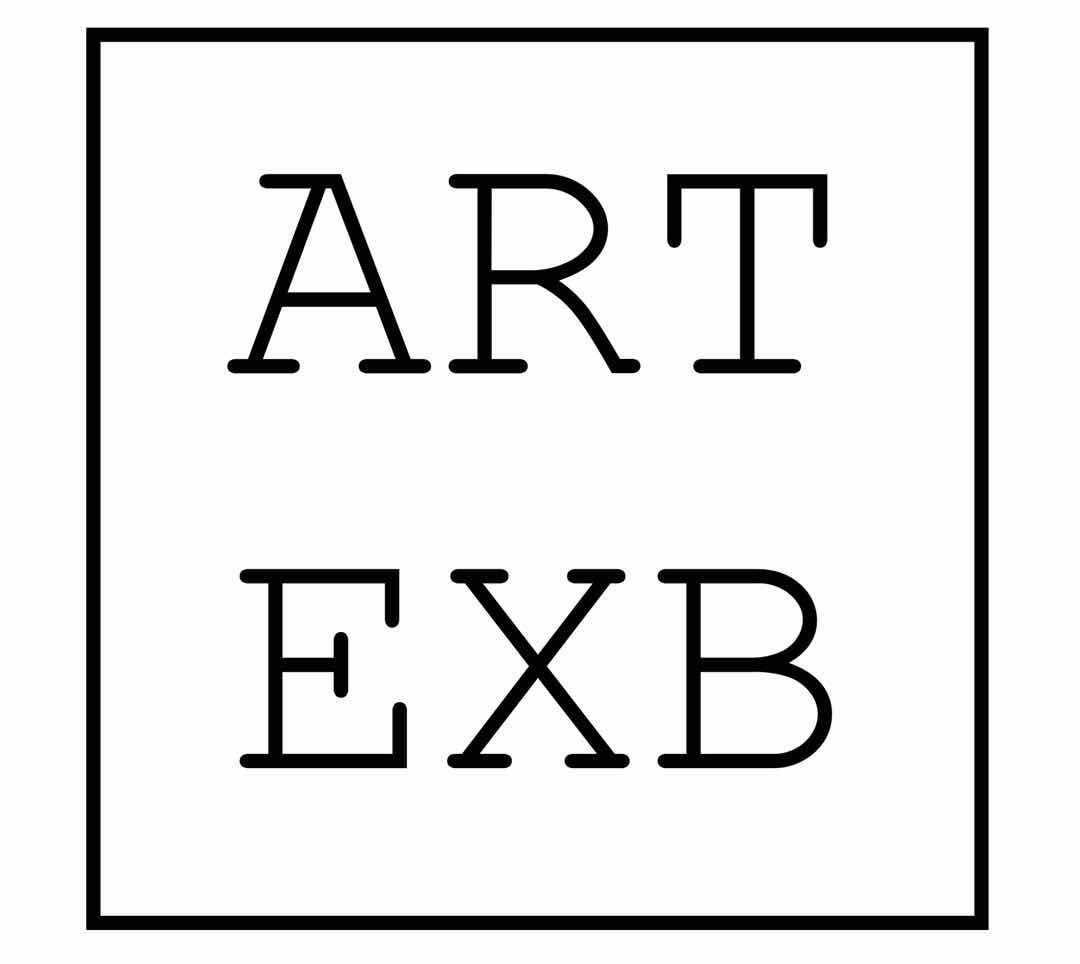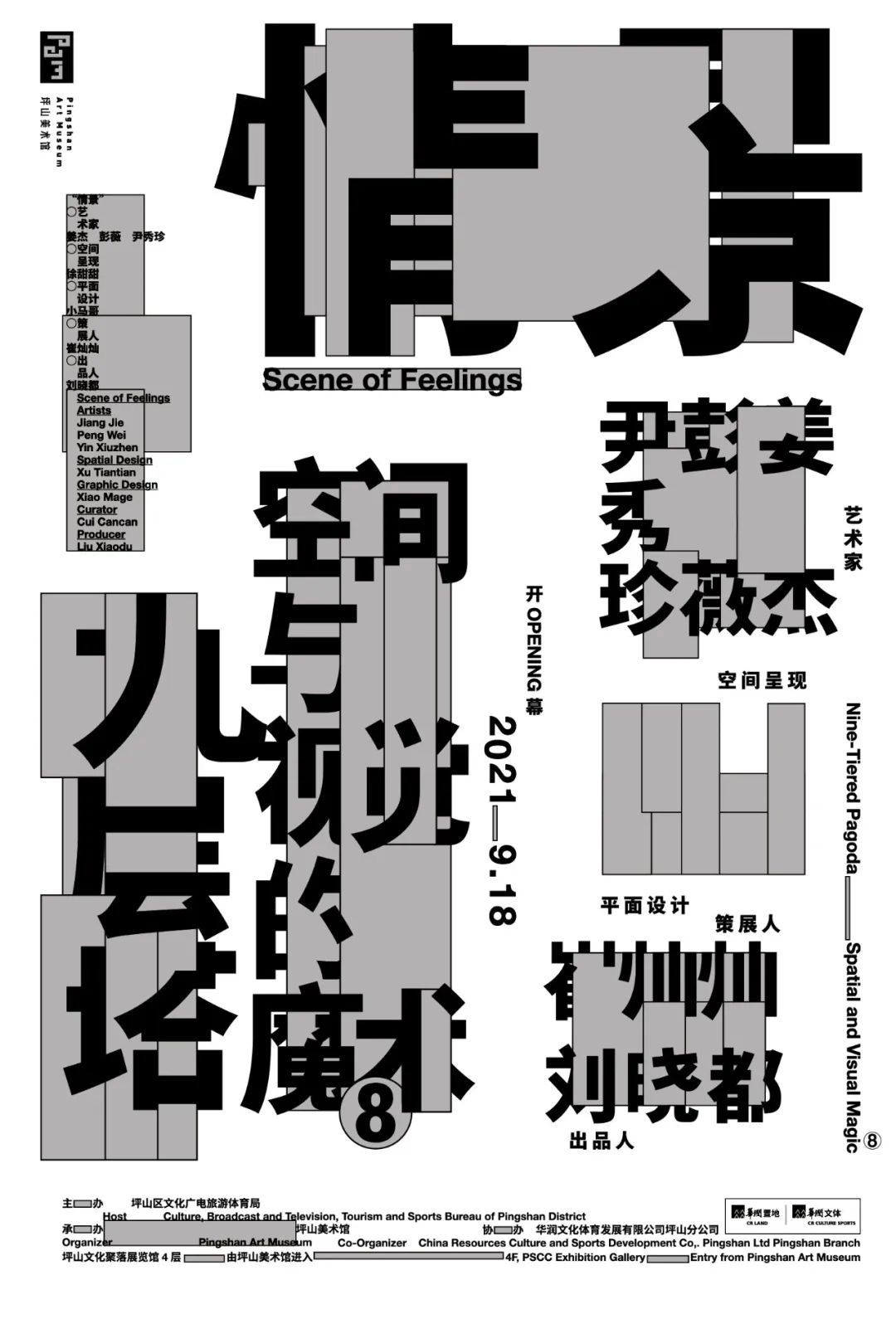“九层塔:空间与视觉的魔术” 是一次跨界行动,是中国从未有过的展览方向和形式。它将邀请9位/组艺术家提供作品,作为展览的基础素材,同时邀请9位建筑师,9位设计师,组成九个临时团队。艺术家、建筑师、设计师三方联名合作,没有 “主次” 和 “中心”,只是分工与协作,最终形成9个全新类型的展览。
空间和设计是决定展览的核心元素,也是对展览和作品的再创作和再生产,它决定了观众看到什么,怎么看,看的次序和节奏。空间和设计,在这里不再是为展览服务,而是独立自主的体验,给予展览无数的变量和可能。
一直以来,我们缺乏一种高质量的跨界,它们不是流俗于明星和网红效应,迎合一种快餐式的出圈,就是自说自话,拘泥于专业壁垒。“九层塔” 倡导的跨界方式,创造了一个艺术、建筑和设计的连接点,一个全新的交叉学科,它既是三个专业间的实际需求,有益协作,又保留了各自的专长和优势,分工得当。
作为中国古代建筑,“塔” 有着一种特殊的结构,它的每一层讲述着不同的故事。这些故事和空间、设计,紧密围绕成一个彼此叠加的整体,成为展览的外在形象和精神内核。
“九层塔:空间与视觉的魔术” 由策展人崔灿灿和建筑师刘晓都共同在2020年发起,它是一个混合了思想、方法、工具的实践项目,也是对跨领域工作的兴趣班,拓展彼此方向的攻关小组。
“九层塔” 的出现,饱含着创造一个全新领域和事业的雄心,旨在发明一种新的合作方式和展览观念,重塑这个时代的感知体验。
“情景” 姜杰、彭薇、尹秀珍
作为九层塔的第八个项目,“情景” 是第一个女性组合,探讨在艺术、建筑、设计中的个体意识和身份差异,以及 “感知” 作为理解世界方式的首要位置。展览以艺术家姜杰、彭薇、尹秀珍的三组作品为基础,邀请建筑师徐甜甜进行空间呈现的创作,平面设计师小马哥进行海报等视觉系统的创作。
睡衣、镜子、苍耳、渔网是姜杰作品中的全部形象。高挂的衣服,镜面的反射,层层叠加的屏障,将形象推向空间,某个相似的情景。和日常酒店房间里的两件睡衣相比,三件,多一件,差异变得异常明显。在情景的世界中,只是一点改变,就会带来许多想象。彭薇的作品来自她创作的不同时期,身体上的⻛景和楼宇,鞋中的情感生活,高塔里层层重叠的故事。原本并不相关的事物,却因为 “女性” 串联在一起。《梦中人》似乎做了另一层解答,不属于一个时代的苏小小与俄国女诗人相遇,却发现有着莫名相似的情境。梦的感知编织了渴望的故事。在展览的入口处,尹秀珍用水泥凝固了那个再也不能重生的往昔,冰冷的材料和生命的温度成为某种可⻅的 “经历”,穿过的衣服承载着记忆、历史和时代的印痕。人们经过这些感知的物证,穿行其间,重返某时某地的情景,一切恍惚有物。
“情景” 描述的是三位艺术家作品中相似的情形。磨碎的袖口,轻坠的苍耳,故事中的身体,这些不同的元素有着同样的功能:创造了一个存在的瞬间,一个进入感知世界的入口,将我们从日常生活引入一个由阅读、感知和想象所主导的世界,一个直觉和情感层层涌动的虚像,在这里信息漂浮不定,故事像在昨夜讲述,种种情愫,使我们前行,又令我们驻足。
建筑师徐甜甜呈现了一个 “感知” 不断过渡和转化的空间,从作品中最细微的身体起伏,到观者和身体距离之间的变化,再到个体身份和公共空间的连接。展厅里既有寄托集体记忆的 “广场”,一格格如园林般的 “曲廊”,也有隐秘而又琐碎的 “寓所”。涌动的曲线将三种空间感知交替、串联,观者置身其中,动态的身体和不远处的作品仿佛成为一体,有过相同的记忆和相似的发生。
设计师小马哥的海报,亦将不同的空间进行模块切割,模糊的感知和情景的差异,在这里变得泾渭分明。“九层塔” – “魔术” – “情景” 这些关键词,将此次展览和过去相连,涌动出绵延不绝的幻化。
在九层塔的第八层,我们借由几位创作者的作品,接近塔顶,接近在艺术、建筑、设计领域中最首要的元素:感知。它是一切视觉文化存在的核心,它可以穿越时间和地域,穿越学科和流派。“感知” 不是故事,不是文本,不是形式,感知是视觉艺术对世界的命名。
策展人 崔灿灿
Nine-Tiered Pagoda: Spatial and Visual Magic, as a cross-disciplinary event, represents an unprecedented direction and form of exhibition in China. Nine (groups of) artists will provide their works as the basis material for the exhibition. Besides, nine architects and nine designers will also join to form nine temporary teams, hence the cooperation among artists, architects and designers. There is no ‘priority’ or ‘center’ in the exhibition, only division of labor and collaboration, presenting nine individual exhibitions of a brand-new type.
As the core determinant for the exhibition, space and design are also a kind of re-creation of the exhibition and the work; They determine the content and how the audience see the exhibition, as well as the sequence and pace. Space and design, no longer in the service of the exhibition, provide an independent and autonomous experience for the audience, granting the exhibition a myriad of variables and possibilities.
There has always been a lack of quality cross-disciplinary exhibitions, which are neither a fast food product preached by celebrities and online influencers nor a highbrow art confined to professional barriers. The cross-disciplinary advocated by Nine-Tiered Pagoda creates a nexus joining art, architecture and design together with a new cross-discipline, which reflects the practical needs and collaboration of the three professions, while it also retains the expertise and strengths of each with a proper division of labor.
As an ancient Chinese architecture, ‘Pagoda’ has a special structure, with each tier telling a different story. These stories, spaces, and designs are closely intertwined with each other into a superimposed whole, formulating the external image and spiritual core of the exhibition.
Nine-Tiered Pagoda: Spatial and Visual Magic, launched by curator Cui Cancan and architect Liu Xiaodu in 2020, is a hands-on project that mixes ideas, methodologies and tools. It’s not only a workshop for cross-disciplinary art, but also a platform for artists, architects and designers to cooperate and expand their development realms together.
The advent of Nine-Tiered Pagoda represents the ambition to create an entirely new field, with an aim to invent a new way of collaboration and to create a fresh exhibition concept that can reshape the perceptual experience of our times.
Scene of Feelings – Jiang Jie, Peng Wei, Yin Xiuzhen
As the eighth project of “Nine-Tiered Pagoda”, “Scenes” is the first exhibition designed all by females to explore the individual consciousness and identity difference in art, architecture, and design, with “perception” serving as the primary tool to understand the world. The exhibition is based on the works of three artists, namely Jiang Jie, Peng Wei and Yin Xiuzhen, with the architect Xu Tiantian creating the space and graphic designer Xiao Mage in charge of posters and other visual systems.
Pajamas, mirrors, xanthium and fish nets are the images in Jiang Jie’s works. The high-hanging clothes, the reflection in the mirrors, as well as the layered screens are pushing these images into the space to form a similar scene. Compared with the ordinary hotel room normally with two pajamas, the extra piece hanged in the exhibition hall is going to stand out easily. In the world of “Scenes”, even the slightest difference can inspire a myriad of imaginations. Peng Wei’s works come from different periods of her creation, presenting sceneries and buildings on the body, the emotional life in the shoes, as well as the overlapping stories in the tower. The originally independent objects are stringed together with the clue of “female”. “The One in My Dreams” seems to provide another answer. Su Xiaoxiao meets a Russian poetess who lived in a completely different era, but finds that they two share an inexplicably similar scene. The perception of dreams weaves the story of desire. At the entrance of the exhibition, Yin Xiuzhen uses cement to freeze the flowing past that can no longer be reproduced. The cold materials and the temperature of life are becoming a certain kind of “experience”. The clothes worn carry the traces of memory, history and the times. When walking through these physical evidences of perception, viewers will revisit the scenes created therein as if they were brought back to a certain time and place.
“Scenes” describes similar settings in the works of three artists. Be it the worn cuffs, the lightly falling xanthium, or the body in the story, all these different elements enjoy the same goal: creating a moment of existence and an entrance into the world of perception, which will guide us into a space dominated by reading, perception and imagination, presenting us a virtual image of intuition and emotions. Information floats here as if all the stories were just told last night, pushing us to move forward while also luring us to stay.
Architect Xu Tiantian presents a space where “perception” is constantly transiting and transforming, from the subtlest body movement in the works, to the changing distance between the viewer and the body, and finally to the connection between individual identity and the public space. In the exhibition hall, viewers will visit a public “square” loaded with collective memories, a garden-like “curved corridor” and trivial hidden “residences” with the surging curves alternating and connecting the three spatial perceptions. They are also becoming a part of the exhibition space as their moving body resonates with the works around, sharing memories and similar occurrences.
The poster created by the graphic designer Xiao Mage cuts different spaces into modules, where the originally vague perception and differences between scenes become more distinct. Such keywords as “Nine-Tiered Pagoda”, “Magics” and “Scenes” connect the exhibition with the past, spurring endlessly illusional changes.
On the eighth floor of the “Nine-Tiered Pagoda”, thanks to the works of these participants, we’re approaching the top where “perception”, the most important element in art, architecture, and design, resides. It is the core of all visual culture which can travel through time and region, as well as through disciplines and genres. “Perception” is not a story, a text, or a form, but rather our naming of the world with visual art.
Cui Cancan, Curator

